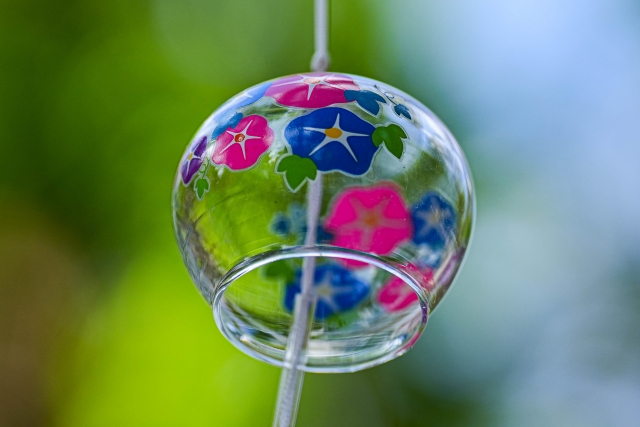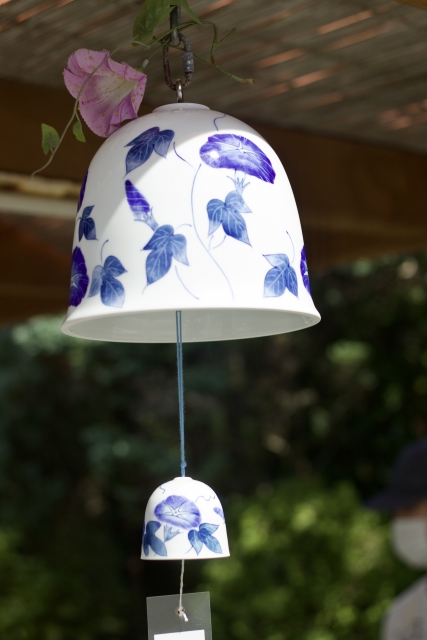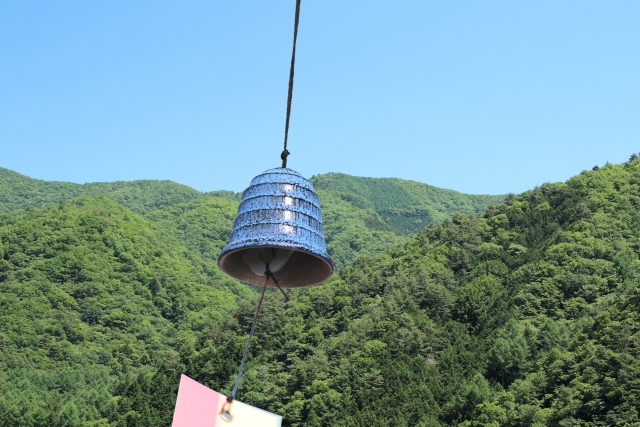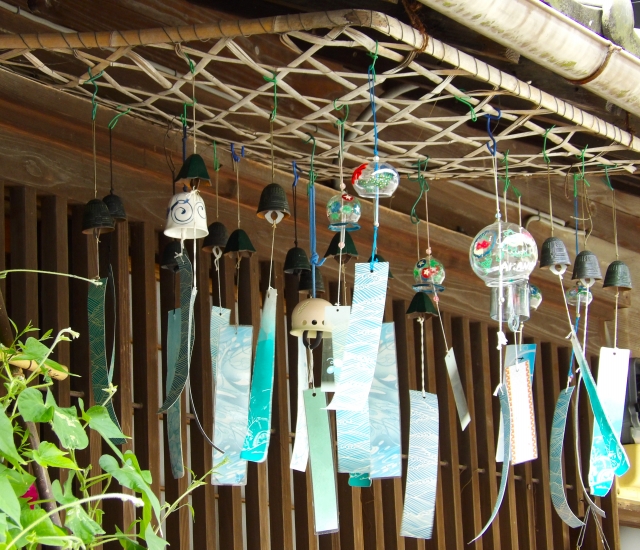introduction
Today we would like to focus on “Fu-ring”, a Japanese summer tradition that soothes our hearts with its delicate tones.
In this article, we will explore how to describe “Fu-ring” in Japanese, as well as the rich cultural background and meaning of the word.
In Japan, the wind chime is more than just an ornament.
It is a soothing object that announces the arrival of summer and makes hot days a little more pleasant with its cool sound.
Its gentle sound visualizes the presence of the wind and makes us feel at one with nature.
In this article, I would like to explore the role of wind chimes in Japanese culture and how they have been integrated into our lives.
Now, let’s enter the world of wind chimes together and explore their beauty and the fascination of the words they reveal.
What is a Fu-ring?
A wind chime is a small but beautiful ornament that transforms the movement of the wind into sound. It soothes our hearts with its light tone and makes us feel the coolness of summer.
Usually made of metal, glass or ceramic, it has a small bell (shumoku) suspended inside. When the wind ruffles the bell, the jaw of the bell strikes the inside of the bell, producing a mournful sound. This simple yet delicate mechanism is the secret of the beautiful sound of wind chimes.
Wind chimes have a long history in Japan, and it is said that the prototype existed as early as the Heian period (794-1185). Originally, they were used as tools to drive out evil spirits and bring in good spirits.
Over time, the fu-ring evolved from a mere tool for driving away evil spirits to a decorative item for enjoying the summer atmosphere. In the Edo period (1603-1867), glass wind chimes were introduced, and their cool sound was associated with the meaning of “taking out the cool air” and became a symbol for relieving the summer heat.
The cultural significance of wind chimes is not only practical in that they are used to cool the body. They symbolize the Japanese people’s sense of oneness with nature, their respect for the four seasons, and their delicate sense of beauty.
The sound of a wind chime not only signals the arrival of summer, but also gives us a chance to temporarily leave our busy daily lives and experience the beauty and transience of nature.
Thus, through its history and cultural background, the wind chime has become an important object that expresses Japanese tradition, aesthetics, and harmony with nature.
It is more than a mere material existence; it is deeply rooted in people’s hearts as a summer tradition in Japan.
Japanese for “Fu-ring “
Fu-ring” is pronounced “fu-ring” in Japanese and written “風鈴” in Chinese. This word is composed of two Chinese characters, “風(wind)” and “鈴(bell),” which mean “wind” and “bell or bells,” respectively.
Therefore, the literal translation of “風鈴” is “wind bell. This refers to a bell that makes a sound when the wind blows, that is, an ornament that transforms the movement of the wind into sound.
Pronunciation Guide Fūrin The “fu” is pronounced by slightly closing the lips and pushing out the air. The “u” is pronounced with the lips slightly relaxed and a short exhalation.
The “u” should be pronounced with the lips slightly relaxed and a short exhalation. The “ri” is pronounced with the tongue slightly curled and close to the upper gums.
The “n” is a nasal sound. Relax your tongue in your mouth and let your breath out through your nose to pronounce it.
Characters (Kana/Kanji)
- Kana : “ふうりん “
- Kanji : “風鈴 “
The pronunciation and writing of the word “Fu-ring” also reveal the beauty of Japanese culture and language.
This simple yet beautiful word symbolizes how wind chimes are deeply connected to Japanese nature and culture.
The expression “Fu-ring” in Japanese has a flavor not only for its sound, but also for the word itself, which has become a popular symbol of summer in Japan.
Types and Designs of Wind Chimes
There are several types of Japanese wind chimes, depending on the materials and designs used.
Each Fu-ring has a unique sound and beauty that makes the most of the characteristics of the material and adds color to the summer landscape.
The most popular types of Fu-rings are made of glass, ceramic and metal.
Glass Fu-rings

Since their appearance in the Edo period (1603-1867), glass-made Fu-rings have been widely popular for their cool appearance and clear tones. Made of transparent glass, these chimes sparkle in the light and produce a pleasant sound when the wind blows.
These chimes are hand-painted with colorful patterns, and many of the designs are based on motifs of summer nature and seasonal festivals.
For example, cool designs such as goldfish and morning glories are popular symbols for relieving the summer heat.
Ceramic Wind Chimes

Ceramic wind chimes are characterized by their simple and warm tones. Born from the power of earth and fire, ceramic evokes a sense of connection to nature and blends into Japanese spaces.
In addition, many ceramic wind chimes are made using traditional pottery techniques, reflecting the characteristics and craftsmanship of each region.
This type of chime is attractive for its muted colors and handmade warmth, and is favored for its design that evokes traditional Japanese beauty.
Metal Wind Chimes

Metal wind chimes are attractive for their vibrant sound and durability. Made of metals such as iron and brass, these chimes have a powerful sound, yet a delicate and pleasant resonance when played by the wind.
Metal wind chimes range from those with simple shapes to those with elaborate decorations, some of which are designed to promote feng shui or good fortune.
The meaning behind the design of each chime and the reasons why certain designs are popular reflect the Japanese people’s deep respect for nature and the changing seasons, as well as their pursuit of beauty.
Fu-ring designs are chosen with great care to create a cool, breezy atmosphere that soothes the viewer’s mind and makes him or her forget the summer heat.
These wind chimes, along with their sound, are a tradition of summer in Japan, and they carry on the beautiful Japanese tradition to the present day.
Tips for Enjoying Wind Chimes
Wind chimes not only provide a pleasant cool on hot summer days, but also remind us of the beautiful Japanese sense of the season.
Decorating your home or garden with wind chimes is a wonderful way to bring their beautiful sound and appearance into your daily life and enrich your enjoyment of the summer season.
Here are some tips for getting the most out of wind chimes, as well as some Japanese seasonal events and customs related to wind chimes.
Wind Chime Decoration Ideas
Hanging on a windowsill or balcony: Wind chimes can be enjoyed to the fullest by hanging them on a windowsill or balcony where the wind blows through.
The sound is produced naturally by the flow of the wind, filling the room with cool tones.
Hang it from a tree in your yard: Hanging the chime from the branches of a tree in your backyard allows you to enjoy the sound of the chime in the midst of nature.
The greenery of the trees combined with the sound of the wind chime will remind you of the beauty of nature in summer.
Install at entrances and porches: To welcome visitors with cool sounds, it is recommended to install wind chimes at entrances and porches.
The sound of the chimes will bring a sense of calm to visitors.
Tips for Enjoying Wind Chimes
Try different types of chimes: There are many different types of wind chimes, including glass, ceramic, and metal.
It is a good idea to try a combination of different types to enjoy their different sounds. Pay attention to the volume of the chime: If the sound of the wind chime is too loud, it can sometimes be perceived as noise.
It is important to choose a wind chime of appropriate size and volume, taking into consideration the environment and location where it will be installed.
Take care of your chime: It is important to take care of your chime to keep its beautiful sound for a long time. Especially for glass-made Fu-rings, wiping and keeping them clean on a regular basis will allow you to enjoy their beautiful appearance for a long time.
Japanese seasonal events and customs related to wind chimes
Fu-ring market: In many parts of Japan, a Fu-ring market is held in the summer.
These are popular summer events where visitors can view and purchase various types of wind chimes.
The Fu-ring Market provides a special opportunity to experience the coming of summer through Fu-rings.
Custom of enjoying wind chimes: In some regions, it is customary to celebrate the change of seasons by participating in wind chime making workshops with family and friends or by decorating wind chimes at home.
This is a popular way to prepare for the coming of summer and to add a sense of coolness to the home during the summer months.
With their delicate tones and beautiful designs, wind chimes are a symbol of summer in Japan. Use these tips to enjoy the charm of wind chimes to the fullest and enrich the summer season.




